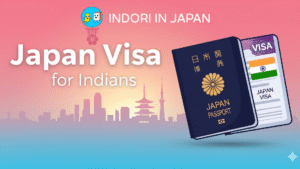Kyoto University’s KU-STAR Program: Your Fully Funded Ticket to a PhD in Japan? The Ultimate Guide for Indian Students
皆さん、こんにちは!(Hello everyone!)
Sapne Dekhna Band Karo, Japan Aane Ki Taiyari Karo! (Stop Dreaming, Start Preparing for Japan!)
Hey everyone, Akash here from Indori in Japan!
Let’s be real. So many of you message me every day with the same dream: “Akash bhai, I want to do my Master’s or PhD from a top university in Japan. I want to do cutting-edge research, but the cost… the process… It’s all so confusing and expensive.” I hear you. The dream of studying abroad, especially in a country like Japan, often feels like it comes with a massive price tag and a mountain of complicated paperwork.
But what if I told you there’s a program that not only smashes that price tag but actually pays you to experience research at one of the world’s most prestigious universities? What if this program were designed specifically for talented students from India?
Stop dreaming and start listening. Today, we’re doing a deep dive into a golden opportunity that could change your life: the Kyoto University Short-Term Academic Research (KU-STAR) Program.
This isn’t just another summer internship. Think of it as your exclusive, fully-funded gateway to a doctoral program at Kyoto University.1 And the best part? This program exists because it aligns with a larger vision. It’s part of the Japanese government’s official policy to attract highly skilled Indian professionals and researchers to Japan. This isn’t just a university inviting you; it’s a country rolling out the red carpet for Indian talent. You’re not just an applicant; you’re part of a strategic partnership between two great nations.
So, grab a cup of chai, get your notepad ready, because this is the ultimate guide to the KU-STAR program. Let’s get you to Japan.
What Exactly is the KU-STAR Program? (It's Not Your Average Internship)
First things first, let’s break down what KU-STAR actually is. The official name is the Kyoto University Short-Term Academic Research Program.1 But that’s a mouthful. Let me explain it in Akash’s style.
Think of the KU-STAR program as a two-month-long audition for your PhD, where the university pays you to be there.
Its core mission is to open the door for undergraduate and Master’s students from India who have a strong, genuine desire to pursue a doctoral program at Kyoto University.1 During the program, which typically runs for about 30-60 days (around 8 weeks), you are placed in a high-level research lab under the direct supervision of a specific faculty member.4 You’ll be working full-time, about 40 hours a week (8 hours x 5 days), contributing to advanced research projects.
But it’s so much more than just lab work. The program is designed to give you a complete 360-degree experience of what life as a graduate student in Japan is really like. You will:
- Conduct Advanced Research: Get hands-on experience in world-class laboratories.
- Understand the Ecosystem: Learn how top-tier research labs function, from daily meetings to long-term project planning.
- Gain Industry Exposure: Visit leading Japanese companies to see how academic research translates into real-world innovation.
- Immerse in the Culture: Participate in activities like Japanese language classes to help you navigate daily life.
- Showcase Your Work: The program culminates in a final poster presentation, giving you experience in communicating your research professionally.
This structure is a brilliant “test drive” for both you and the university. For you, it’s a risk-free way to see if the lab’s research, the professor’s mentorship style, and life in the beautiful city of Kyoto are the right fit before you commit 3-5 years to a PhD. For Kyoto University, it’s the perfect way to identify and evaluate the most promising, adaptable, and motivated students from India—something no transcript or Statement of Purpose can ever truly capture. This is a strategic, mutual evaluation process, and understanding this is the key to a successful application.
The Golden Checklist: Are You Eligible for KU-STAR?
Alright, now for the most important question: “Am I eligible?” Let’s cut through the jargon and create a simple checklist. If you can tick all these boxes, you should definitely apply.
- You’re Studying in India: You must be enrolled in an undergraduate or Master’s program at a college or university located in India.
- Akash’s Tip: They are specifically looking for talent from Indian institutions. The inaugural cohort in 2024 had students from top IITs (Madras, Bombay, Delhi, Kharagpur, Kanpur). While this shows they value top-tier institutes, students from any recognised Indian university with a strong profile should apply.
- You’re at the Right Academic Stage:
- Undergraduate Students: You must have completed at least four semesters of your degree before the internship begins.
- Master’s Students: You can be in any year of your Master’s program.
- Your Studies Will Continue: This is a crucial point. You cannot graduate right before the program starts. You must be scheduled to continue your academic program (UG or Master’s) for at least one semester or quarter after you return to India.
- Akash’s Tip: Why this rule? Because this program is an investment in your academic journey, which they hope will lead back to Kyoto. They want to ensure you are still an active student when you complete the program.
- You Have a Good Academic Record: The guidelines state you need a “good academic record” or “strong academic performance record”.
- Akash’s Tip: They don’t specify a minimum CGPA, but this is Kyoto University—one of the best in the world. Aim to be in the top tier of your class. However, don’t let a slightly lower CGPA discourage you if you have strong research experience or publications.
- You Meet Your Chosen Lab’s Requirements: You’ll need to check the “Laboratory List” provided on the KU-STAR website. Each lab may have specific requirements regarding skills, knowledge, or degree background (e.g., knowledge of Python, experience with cell cultures, etc.).
- The #1 Most Important Rule: You must have a “strong desire to pursue a doctoral program at Kyoto University”.
- Akash’s Tip: Listen to me carefully. This is the single most important filter for the selection committee. This phrase is repeated in every official document for a reason. They are not looking for a tourist or someone just wanting a summer internship certificate. They are scouting for their future PhD students. Your entire application, especially your “future study and career plan,” needs to scream this passion and commitment. You must connect the dots between your past projects, your current skills, and why a specific lab at Kyoto University is the only place you want to be for your future PhD. Spend 80% of your effort on this narrative.
The Best Part: Let's Talk Money, Accommodation, and Perks!
Now for the section you’ve all been waiting for. Ab aayi kaam ki baat – paisa! This is where the KU-STAR program goes from a great opportunity to an unbelievable one. Forget worrying about education loans or saving up for years. Kyoto University has it all covered.
Here’s the breakdown of the financial package:
1. Free Accommodation
This is a massive benefit that many people underestimate. The guidelines clearly state: “Kyoto University will arrange accommodation for all participants for the internship period”. Rent is the single biggest expense for any student in Japan, often costing between JPY 45,000 to JPY 55,000 per month in a city like Kyoto. The KU-STAR program takes this entire burden off your shoulders. You get a place to stay, sorted.
2. A Generous Scholarship (aka Your Salary)
This isn’t just a small stipend to cover your food. It’s a significant daily scholarship. You will receive JPY 5,000 per day.
Let that sink in. And the best part? The official website confirms this includes weekends and holidays!
Let’s do the math to see what this really means for your wallet.
| Category | KU-STAR Monthly Stipend (JPY) | Estimated Monthly Cost in Kyoto (JPY) | Your Net Position |
|---|---|---|---|
| Daily Stipend | 5,000 | - | - |
| Monthly Stipend (x30 days) | 150,000 | - | - |
| Accommodation | Provided by KU | ~45,000 | You saved this entire amount! |
| Food | - | ~30,000 | - |
| Transportation | - | ~10,000 | - |
| Personal/Social Expenses | - | ~30,000 | - |
| Total Estimated Expenses (without rent) | - | ~70,000 | - |
| Your Monthly Surplus (Approx.) | - | - | +80,000 JPY |
Note: Cost of living estimates are based on data for international students in Kyoto.
As you can see, the monthly stipend of JPY 150,000 is more than double your estimated living expenses because your rent is already paid for. This leaves you with a surplus of around JPY 80,000 (over 45,000 INR) per month!
This isn’t just a “fully funded” program where you break even. This is a program where you can live comfortably, explore the beautiful city of Kyoto, travel a bit on the weekends, and still save a significant amount of money. It’s an incredible deal that removes all financial stress, allowing you to focus 100% on your research and experience.
Your Step-by-Step Application Guide (Don't Mess This Up!)
An opportunity this good is obviously competitive. For the 2025 program, there were 519 applicants for just 31 spots. So, your application needs to be perfect. Dhyaan se suno, ek bhi step miss mat karna. The application process itself is your first test of how organised and serious you are.
Here is the official process, with my pro tips for each step:
Step 1: Prepare in Advance (The Pre-Application Phase)
The application window is extremely short—for the 2025 program, it was just over two weeks, from January 14 to January 31. You cannot start preparing on day one.
- Download the Application Guide and Lab List: As soon as they are released, download these documents from the KU-STAR website. Read them multiple times.
- Shortlist Your Labs: Go through the laboratory list PDF carefully. Identify 2-3 labs that perfectly match your research interests and background.
- Contact Your Recommender: You will need one letter of recommendation. Contact your professor or mentor weeks before the application opens. Explain the program to them, tell them why you’re a good fit, and politely ask if they would be willing to write a strong recommendation. Give them all the necessary information and a clear deadline.
Step 2: The Online Application
Once the application period opens, it’s go-time.
- Create an Account: Go to the online application system link provided on the KU-STAR website and create your account.
- Request Recommendation Letter: Inside the system, you will need to formally request the recommendation letter from the professor you already spoke to. You’ll need to provide their details, and the system will send them a link to upload their letter. Follow up with your recommender to ensure they received the link and know your Application ID.
- Fill in Your Information: Complete all the required fields in the online form. Double-check for any typos or errors.
Step 3: Upload Your Documents
This is where your preparation pays off. You’ll need to upload a few key documents.
- Your CV: There is no specific format, but it must include your academic background, any awards you’ve received, and any publications. Make sure it is clean, professional, and tailored to a research position.
- Future Study and Career Plan: This is the most important document. As I mentioned before, this is where you prove your “strong desire” for a PhD at Kyoto University. Be specific. Name the professor you want to work with, mention their recent papers, and explain how their research aligns with your long-term goals.
Step 4: Final Submission
- Check Everything: Before you hit submit, make sure all your information is filled out, all your documents are uploaded, and—crucially—that your recommender has uploaded their letter. The system will not let you submit until everything is complete.
- Mind the Deadline: The deadline is strict. For 2025, it was January 31, 5 p.m. Japan Standard Time (JST). Remember, JST is 3.5 hours ahead of IST. Don’t get caught out by the time difference! Aim to submit at least a day or two early to avoid any last-minute technical glitches.
Beyond the Books: The REAL KU-STAR Experience (Student Stories)
So, what’s it actually like to be a KU-STAR scholar? This isn’t just about sitting in a lab all day. The program is meticulously designed to give you a rich, immersive experience. Based on the university’s own reports and student feedback, here’s a glimpse into your two months in Kyoto.
The Kick-Off: A Warm Welcome
The program begins with a comprehensive orientation session, a welcome lunch, and a campus tour. This is where you’ll meet the other 30-odd brilliant students from across India. Past participants mention how they quickly bonded with their fellow scholars and student tutors from Kyoto University during these initial events, forming a strong support system from day one.
Bridging Cultures: Japanese Classes and City Exploration
To help you feel at home, the program includes dedicated “survival” Japanese language classes. You’ll learn the basics to order food, ask for directions, and navigate daily life. The university even organises cultural tours to iconic locations like Nijo Castle, giving you a chance to soak in the history of Japan’s ancient capital.
"Innovation in Action": High-Profile Industry Visits
This is a standout feature of the KU-STAR program. You get exclusive, behind-the-scenes access to some of Japan’s most innovative global companies. Past cohorts have visited:
- Samco Inc.: A global semiconductor manufacturing equipment company.
- HORIBA Ltd.: A world leader in advanced analytical and measurement technology.
- DMG MORI CO., LTD.: A giant in the machine tool industry, where students witnessed cutting-edge automation.
These aren’t just passive tours. Students engage in deep discussions with company engineers and leaders. At HORIBA, the Indian students had a lively Q&A session with Indian employees working there, getting firsthand advice on building a career in Japan.
The feedback from Indian students is glowing.
- Hemanta from IIT Kharagpur called the visit to HORIBA an “excellent experience” that provided “clear insight into their advanced technologies and work culture” and valuable “networking opportunities”.
- Anand from IISc was impressed by the “beautiful working environment” at HORIBA and the “amazing” machines at DMG MORI.
- Amritha from IIT Hyderabad found the automation technology at DMG MORI “intriguing”.
These visits are designed to show you the direct line from your lab research to real-world impact, and to build your professional network in Japan from the very beginning.
The Grand Finale: Showcasing Your Success
The program concludes with a formal Final Presentation Session. You’ll create a research poster and present your findings to your supervisors, lab mates, and other Kyoto University faculty. It’s a fantastic opportunity to practice your scientific communication skills in a professional setting. After the presentations, you are awarded a certificate of completion, and there’s a social gathering to celebrate your achievements. It’s the perfect end to an intensive, rewarding journey.
Is the KU-STAR Program Your Gateway to a Future in Japan?
The Problem with "Going It Alone"
So, let’s bring it all home. Is the KU-STAR program worth it?
Absolutely. This is more than an internship; it’s an invitation. It’s a carefully crafted pipeline designed to bring the brightest young minds from India into one of the world’s top research ecosystems. The university’s goal is explicitly stated: they strongly hope that participants will “return to Kyoto University in the future as Master’s program or doctoral students or researchers”. They are investing in you because they see you as their future.
By participating, you are not just getting a prestigious line on your CV. You are positioning yourself at the forefront of the growing strategic relationship between India and Japan. This is a wave of opportunity that can lead not just to a PhD, but to a high-flying career, and maybe even a long-term future in Japan—a path that I talk about all the time on this blog.
The competition is tough, but the rewards are immeasurable. You get to conduct research with world-renowned professors, experience Japanese culture, build a professional network, and do it all without any financial burden.
Kyoto University is looking for the best from India. The only question is, are you ready to answer the call?
For all official information, the application guide, and the lab list, keep a close eye on the official website:
For any specific inquiries, you can reach out to the dedicated India office:
- Email: indiadesk-ku@mail2.adm.kyoto-u.ac.jp
Don’t let this opportunity slip by. Start preparing now, craft an application that showcases your passion, and you might just find yourself spending a life-changing summer in the heart of Japan.
Keep dreaming, and keep working hard. I’ll see you in Japan!
Ganbatte! (Do your Best!)
✍️ Bonus: Need Help Starting?
✅ Job hunting tips and real listings for foreigners in Japan
✅ Visa guidance made simple—no confusing search
✅ Resume & cover letter templates (Japanese & English formats)
✅ Life in Japan explained — from rent to ramen
✅ Travel guides & city recommendations for every kind of explorer
✅ Work culture insights to help you adjust and thrive





